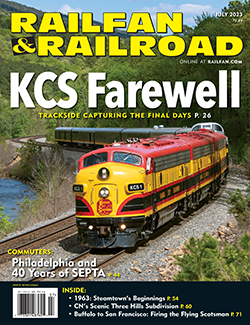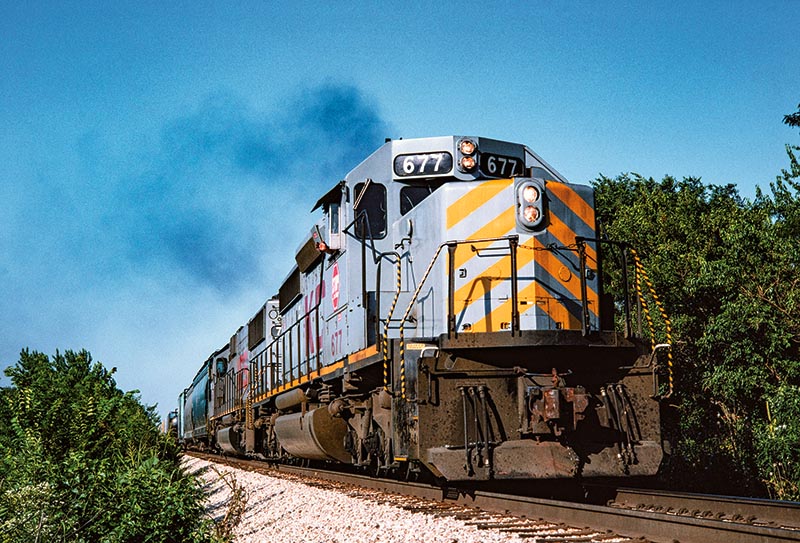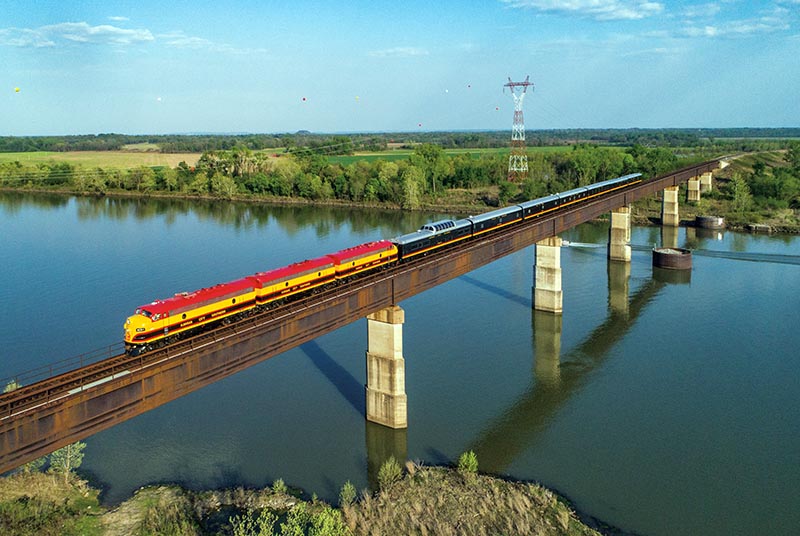 by Kevin EuDaly/photos by the author
by Kevin EuDaly/photos by the author
The Dresses of Miss Belle
I first met Miss Belle on a Saturday, the last day of March, in 1973. She was dressed in white. I likely had seen her before, but have no record of any prior encounters. I was 13 and have no photographs of the first time we met, but I have my trusty journal entry. I suspect my brother Lon has photographs — I was the tagalong recordkeeper as Miss Belle drifted down the hill and across the concrete arch bridge over Gregory Boulevard in Kansas City, Mo.
I saw her three times that April, always in white with a splash of red. In May she was dressed in red twice and in black twice, and we met on 11 occasions. A romance had begun, and this was getting serious. A year passed, and she was soon in the picture — that spring, at the age of 14, I got my first camera. She first shows up on film in May, then again in August, and our friendship took off from there.

ABOVE — Dressed in Gray: A southbound manifest behind SD40-2 677 nears the top of the grade in Grandview, Mo., on July 10, 1995. The gray scheme, adopted in 1989, was essentially an exchange of white for gray and the addition of yellow nose chevrons. In my opinion, it wasn’t an improvement and didn’t result in any additional desire to photograph KCS, especially when that same year then-President Michael R. Haverty restored Santa Fe’s iconic red and silver warbonnet paint scheme.
But childhood friends and the romances of early youth almost always fade into the fabric of the past. Prettier targets come along — or more elegant distractions — and those first friends find themselves only occasionally entertained. Junior high school disappeared into high school, and high school into college, and college into careers, but Miss Belle was always there along the way. During high school, the horizons expanded; there were those dressed in dark blue, blue and yellow, green and yellow, green and black and white, and yellow and gray. There were a lot of choices in Kansas City. The one in dark blue was prevalent in college, as was one in red and white, and with the post-college career, the horizons expanded once again, and any color of the rainbow was available.
After years of wearing white, she adopted gray — not a prettier dress in my eyes — and by this time our friendship was a more casual one, with only occasional meetings. This was partly due to a prettier rival — across town someone adorned in red and silver became a favorite, and “distracted” is a mild description for why Miss Belle and I drifted apart. Red and silver lasted only six years, beginning to disappear when Miss Warbonnet found a suitor that chose orange.

ABOVE — Era of the Belles: By the end of 2012, the combination of large orders for new units and the repainting of older power resulted in the Belle scheme becoming much more prevalent. A light power move heading north on the north side of Heavener, Okla., on November 1, 2012, illustrates that with seven Belles, three KCS gray units, one UP unit, and one BNSF unit. SD70ACe 4135 in the lead is in brand-new paint after EMDX 2100–2109 were sold to KCS the month before. Light power moves like this one are moving units from Wade, Ark., back to Pittsburg, Kan., where they are added to southbound trains that need extra horsepower to conquer the mountain grades.
Then, something remarkable happened. Miss Belle chose a new attire, this time no plain white or drab gray, but sparkling red, yellow, and black. These were colors meant for the camera, and I suddenly found myself enamored with her once again. The frequency of our encounters increased consistently for a number of years and then one fateful day we met again, and this time she was wearing that dazzling red, yellow, and black.
A Project is Born
Though I first experienced KCS as an early teen and it was fairly constantly woven into my photographic efforts, it wasn’t a road that I went much out of the way to photograph. The fact that it was the closest railroad to home on Kansas City’s east side was the primary reason it garnered attention. But the other reason was it was the hometown road. Any time visitors came to Kansas City, it seemed one of the primary requests was to capture KCS action. With headquarters and the northern terminus of the road in my backyard, images piled up.

ABOVE — Sailing Away: “The Belle” sails high above the Arkansas River north of Spiro on April 12, 2023, scurrying north for its appointment with the merger ceremony in Kansas City two days later. Ian Murray and Jim DeNike were there, and once the business train disappeared, Ian headed north to attempt another shot. Jim and I spent a few pleasant minutes visiting before going our separate ways. KCS’s Belle days were over for us.
For me, KCS’s recent history is inextricably tied to Santa Fe’s on several fronts. While Santa Fe’s ownership of Gateway Western — which eventually was purchased by KCS — is one of those, the real link is a single person: Michael R. Haverty. In 1989, Haverty was president of Santa Fe, and in a bold and brilliant move restored red and silver warbonnet paint, first to FP45s 101 and 102, and then specified that new power would arrive in the same beautiful scheme.
It was a watershed moment for railroad photography, and the buzz and excitement were prevalent across the system. Haverty resigned from Santa Fe in June 1991, but his red and silver legacy continued until Santa Fe was merged into BNSF. Even under BNSF ownership, the red and silver scheme survived for awhile with big “BNSF” lettering on the flanks of locomotives, but all too soon it disappeared under a wave of orange paint…
